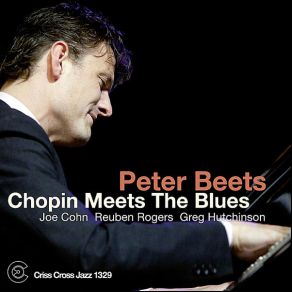Chopin Meets the Blues
Download links and information about Chopin Meets the Blues by Peter Beets, Joe Cohn, Reuben Rogers. This album was released in 2010 and it belongs to Jazz genres. It contains 8 tracks with total duration of 01:00:57 minutes.

|
|
|---|---|
| Artist: | Peter Beets, Joe Cohn, Reuben Rogers |
| Release date: | 2010 |
| Genre: | Jazz |
| Tracks: | 8 |
| Duration: | 01:00:57 |
| Buy it NOW at: | |
| Buy on iTunes $9.99 | |
Tracks
[Edit]| No. | Title | Length |
|---|---|---|
| 1. | Nocturne in E-Flat Major, Op. 9 No. 2 | 10:04 |
| 2. | Nocturne in F Minor, Op. 55 No. 1 - 1 | 7:39 |
| 3. | Mazurka in A Minor, Op. 17 No. 4 | 8:25 |
| 4. | Prelude in B Minor, Op. 28 No. 6 | 7:04 |
| 5. | Prelude in E Minor, Op. 28 No. 4 | 5:35 |
| 6. | Nocturne in B Major, Op. 9 No. 3 | 7:35 |
| 7. | Waltz in C-Sharp Minor, Op. 64 No. 2 | 7:15 |
| 8. | Nocturne in F Minor, Op. 55 No. 1 | 7:20 |
Details
[Edit]Dutch pianist Peter Beets avoids the word jazz in describing his music, believing that the word "tends to turn many people off." And he points out, reasonably enough on both counts, that the heavily chromatic nature of Chopin's piano writing includes passages that suggest what came to be known as blue notes, and that the Creoles, at least, among the creators of jazz probably would have heard some Chopin in still-French New Orleans. In any event, this isn't some odd attempt to shoehorn Chopin into blues harmonies; it's a set of eight jazz treatments of Chopin by a quartet consisting of piano (Beets himself), guitar, bass, and drums. It's not fundamentally different in concept from previous jazz versions of classical pieces, but it's quite enjoyable, and it makes you wonder why Chopin is so rarely the one selected for this kind of thing. His harmonic rhythms are regular, and his melodies tend to fall into clear periods amenable to jazz improvisation. His music is all about ornamentation and harmonic complexity, and the players substitute jazz versions of these for Chopin's own conceptions in varying measures and degrees. On the spectrum between using a piece only for basic melodic inspiration and simply adding jazz rhythms to the established text, Beets and company fall somewhere near the middle: there is heavy use of Chopin, but the quartet tends to depart from the original once a firm foundation has been laid. The music emphasizes Chopin's fondness for the device of repeating a melodic figure, like the 6-5 move in the Prelude in E minor, Op. 28/4, a device many a jazz pianist has used. An unusual item that will be enjoyed by lovers of classical-jazz fusions.~James Manheim, Rovi